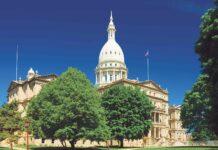This is third in a series on how electricity is generated. The first (January) was about clean-coal technology, and the second about new nuclear options (June). Watch future issues for stories about other fuel sources.
For many, answers to our nation’s energy and climate change challenges lie in the wind. From commercial wind farms to backyard setups, the sky scraping structures with massive rotating blades have become synonymous with “going green.”
At the end of 2012, wind generated about 60,000 megawatts of electricity in the United States—enough to serve over 15 million homes. Wind power production is booming, with output increasing leaps and bounds over the past several years.
Costs are dropping for wind power projects, although federal subsidies are still necessary for wind to compete with traditional sources of electricity generation. A January 2012 study from the U.S. Department of Energy’s Lawrence Berkeley National Laboratory reports it costs between 24 percent and 39 percent less to produce wind energy on a per?kilowatt?hour basis today than it did a decade ago.
As of early 2013, 50 electric co-ops either own wind turbines or buy output from wind farms, amounting to 4.3 gigawatts (GW), or about 9 percent of the U.S. wind generating capacity, according to the American Wind Energy Association.
Like any resource, wind has pluses and minuses when it comes to making electricity. Here’s a look at how wind power stacks up.
Intermittency Issues
Wind power development opportunities vary greatly throughout the country. It’s viable in many states, ranging from the Great Plains and Midwest as well as the Atlantic Coast, but is limited in the Southeast and Southwest.
Yet even in locations with strong wind resources, an active wind turbine typically only generates 30 to 40 percent of its “capacity factor”—the total electricity it could generate operating around-the-clock. A 2010 National Renewable Energy Laboratory survey found less than 1 percent of land in states like Alabama, Kentucky and Georgia was windy enough to achieve at least 30 percent capacity factor.
Wind is also an “intermittent” fuel source. The wind doesn’t blow all the time, so electricity generation is not reliable or constant. Energy from wind usually peaks in the early morning, when most people are still sleeping and not using electricity. Intermittency means coal- and natural gas-fired power plants must act as backups so electricity continues to flow as needed when the wind isn’t blowing. Backup power sources increase the total cost of wind generation.
Energy Storage
As of now, technology to store power from renewable energy—so it can be used later—is still immature and expensive. Wind and other renewables could become more valuable as advancements in energy storage systems are tested. First developed in the 1970s, energy storage is becoming more economical on a large scale thanks to recent manufacturing breakthroughs that increase the longevity while lowering the cost of batteries. With energy storage, the electricity produced by wind can be used during times of peak demand—the electric utility industry’s version of rush-hour traffic, when power use skyrockets—to avoid buying expensive backup power.
“Energy storage would also reduce the intermittency of wind, which allows for more efficient use of backup generators, among other benefits,” says Doug Danley, technical liaison on renewable and distributed energy for the Cooperative Research Network. “CRN is continuing to study energy storage systems so that electric co-ops can best use these technologies to the advantage of their consumer-members.”
Environment & Transmission
Before turbines go up, studies must be done to judge the wind’s variability in a given area. And although the sight of a tall, white wind tower may not be as intrusive as other types of power plants, environmental and economic impacts must be assessed. Will the turbine kill songbirds and bats, or disrupt their migratory patterns? Will shipping routes be affected by an offshore wind farm?
Once the electricity is produced, moving it from a wind farm to homes can be difficult. Transmission infrastructure may not be available in areas where the wind blows best, and building new transmission lines takes time, money, and a lengthy regulatory approval process.
Investing in Local Communities
The clear advantage to wind power is its “renewable” status, but there can be economic benefits, too. Fifty-three remote communities served by Alaska Village Electric Cooperative, based in Anchorage, are able to harness wind and reduce their dependence on pricey diesel fuel that led to retail electricity rates of 51 cents per kilowatt-hour, almost five times the national average.
Some rural communities are developing wind power to revitalize their economies. In Missouri, Atchison-Holt Electric Cooperative was losing businesses and young people until it discovered growth through renewable energy. Building several wind projects spurred an economic renaissance that included biodiesel plants and new small businesses.
In a similar boon of local investment in 2010, the South Dakota Wind Partners venture garnered $16.6 million from over 600 investors to build the Wessington Springs Wind Farm near White Lake. As required by law, all investors were South Dakotans, but most were also associated with one or more of the farm’s organizers: East River Electric Power Cooperative, a generation and transmission co-op in Madison; South Dakota Farm Bureau Federation; South Dakota Farmers Union; and the South Dakota Corn Utilization Council.
South Dakota Wind Partners was possible after the passage of the federal stimulus bill, which created the 1603 grant-in-lieu of tax credits program providing a cash payment (tax grant) of up to 30 percent of qualifying project costs. This provision expired in 2011.
“Were it not for 1603 tax grants, the Wessington Springs Wind Farm would not have happened,” notes Jeff Nelson, East River Electric Power general manager. “It opened the door for small investors to come together to create a unique, locally-owned community wind project.”
Electric Co-ops Working for You
While great strides have been made to include renewable energies like wind power into America’s electricity generation portfolio, making wind work as a reliable, affordable energy source will take time. Electric co-ops, including Michigan’s, have long been on the forefront of new technologies.
For example, Wolverine Power Cooperative, in Cadillac, MI, has purchased the total output of the Harvest Wind Farm, the state’s first commercial-scale wind project, to serve its member co-ops since the farm began generating electricity in December 2007.
All Michigan electric co-ops will continue to evaluate and implement renewable energy opportunities that work for their member-owners. To find fuel mix percentages for your co-op, go to countrylines.com and click on “My Co-op”/co-op name/March issue.
– Magen Howard





